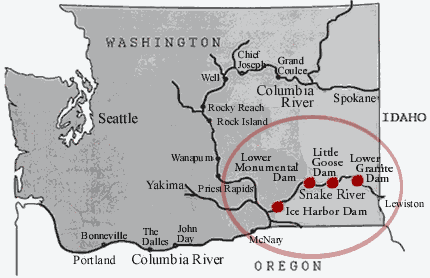forum
library
tutorial
contact

Easy to Blame Dams
by Fred CloeThe Columbian, June 2, 2012
|
the film forum library tutorial contact |

|
Easy to Blame Damsby Fred CloeThe Columbian, June 2, 2012 |
Blaming the dams entirely for the salmon recovery failure is one example. A look at the fish count records of Bonneville and McNary dams will show the runs actually increased after the states outlawed fish wheels and gillnets above Bonneville. The same records will show a decrease in the count after the Native American fishery began using gillnets as the usual and accustomed manner of fishing.
I would agree with Anderson about over-fishing. Gillnets should not be used on the river at all, especially set nets, of which there are now hundreds between Bonneville and McNary.
The Native American fishery needs to be controlled, and we, the people, need to know the fishing rights were bought and paid for when the dams were built. Fishing should only be by dip net, as per the treaty rights.
Related Pages:
I reiterate; before dams good years for the Columbia and its associated watersheds was about 93,000,000 salmonids over all species.
Actually, in the 1880's fisheries in WA and OR were shut down temporarily because of overfishing. Um, and remember we had graced the indiginous population with smallpox, syphillis, and other various wonders from Europe, including 'lead poisoning' from Colt and Wincester and reduced their populations where, well, there were more Chinook salmon around than members of the tribe. So, fishwheels, nets, trolling, and yes a meager amount of the Original People with dipnets were all part of the demise of large salmon runs.
Today we can blame dams, and less habtitat each year, not to mention all us nice folk's chemicals from herbicides on very green lawns down to some river's edge to estrogen and other wonders of chemical research.
There is research that definitively shows that salmonid juveniles will move into streams as small as 3-6' wide to overwinter and grow, and many move into seasonal/intermittent streams. Hmm, so that drainage ditch in Tom's back forty may have...... Wow!
 Reading Jon C. Anderson's May 26 letter, "," I'm struck by some misguided information.
Reading Jon C. Anderson's May 26 letter, "," I'm struck by some misguided information.
Judge Finally Comes Clean on Dam Breaching Walla Walla Union Bulletin, 4/30/12
Posted by Jim Comrada, University of Washington; South Seattle Community College
Sorry, once more only part of the story is told.
Fred Cloe, Skamani
Easy to Blame Dams
The Columbian, June 2, 2012
learn more on topics covered in the film
see the video
read the script
learn the songs
discussion forum
